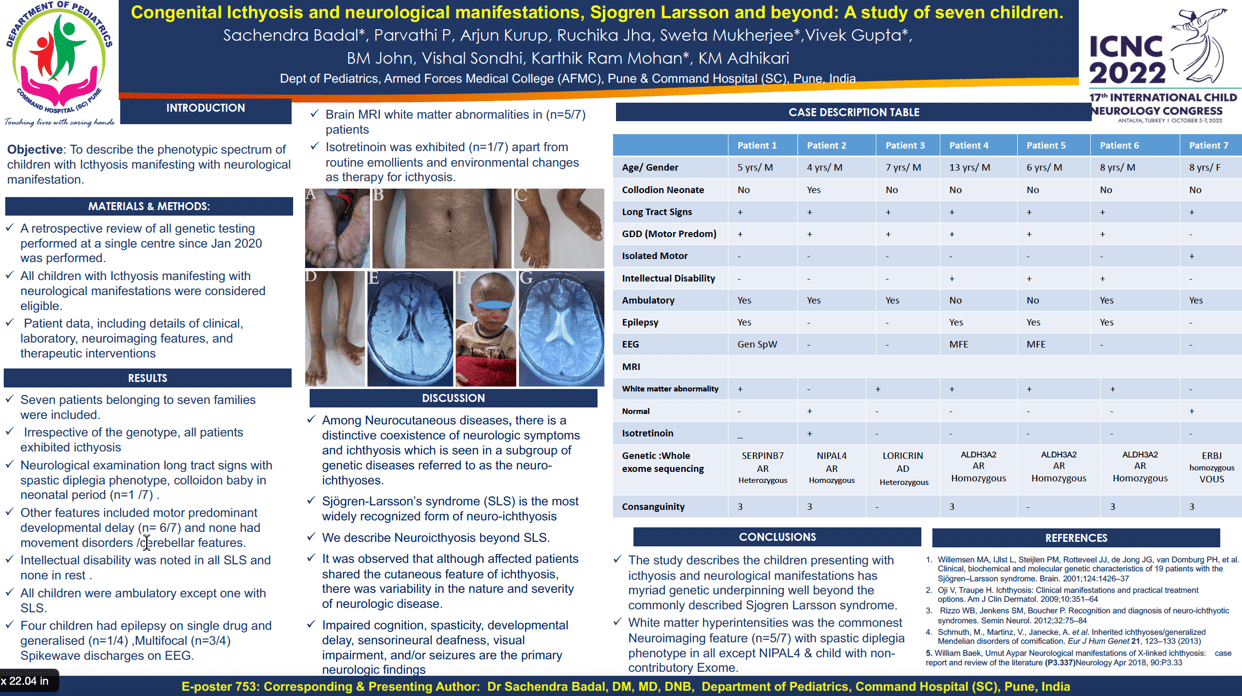Congenital Icthyosis and neurological manifestations, Sjogren Larsson and beyond: A study of seven children.
Sachendra Badal, Parvathi Parappil, Arjun Kurup, Ruchika Jha, Sweta Mukherjee, Vivek Gupta, Biju M John, Vishal Sondhi, Karthik Ram Mohan, KM Adhikari
Objective To describe the phenotypic spectrum of children with Congenital Icthyosis manifesting with neurological manifestations Methods A retrospective review of all genetic testing performed at a single Centre since Jan 2020 was performed. All children with Icthyosis manifesting with neurological manifestations were considered eligible. Patient data, including details of clinical, laboratory, neuroimaging features, and therapeutic interventions.
Results Seven patients (six male) belonging to seven families were included. The patients were Autosomal Recessive homozygous variations in ALDH3A2 (n=3), NIPAL4 (n=1), & compound heterozygotes in SERPINB7 (n=1) and Autosomal Dominant in LORICIN (n=1), Non-contributory Exome (n=1). Irrespective of the genotype, all patients exhibited icthyosis and on neurological examination long tract signs with spastic diplegia phenotype, colloidon baby in neonatal period (n=1 /7) .Other features included motor predominant developmental delay (n= 6/7) and none had movement disorders /cerebellar features. Intellectual disability was noted in all SLS and none in rest .All children were ambulatory except one with SLS. Four children had epilepsy on single drug and generalized (n=1/4) ,Multifocal (n=3/4) Spikewave discharges on EEG. Brain MRI demonstrated white matter abnormalities in (n=5/7) patients; no other structural abnormality was identified for other patients. Isotretinoin was exhibited (n=1/7) apart from routine emollients and environmental changes as therapy for icthyosis. Conclusion The study describes the children presenting with icthyosis and neurological manifestations has myriad genetic underpinning well beyond the commonly described Sjogren Larsson syndrome. White matter hyperintensities was the commonest Neuroimaging feature (n=5/7) with spastic diplegia phenotype in all except NIPAL4 & non-contributory Exome children.
Keywords:
- Icthyosis, Loricin, Voshwinkel , Sjogren Larsson , Vici Syndrome
Sachendra Badal
ARMED FORCES MEDICAL COLLEGE
India
Parvathi Parappil
AFMC
India
Arjun Kurup
AFMC
India
Ruchika Jha
AFMC
India
Sweta Mukherjee
AFMC
India
Vivek Gupta
AFMC
India
Biju M John
AFMC
India
Vishal Sondhi
AFMC
India
Karthik Ram Mohan
COMMAND HOSPITAL SC
India
KM Adhikari
AFMC
India
Objective To describe the phenotypic spectrum of children with Congenital Icthyosis manifesting with neurological manifestations Methods A retrospective review of all genetic testing performed at a single Centre since Jan 2020 was performed. All children with Icthyosis manifesting with neurological manifestations were considered eligible. Patient data, including details of clinical, laboratory, neuroimaging features, and therapeutic interventions.
Results Seven patients (six male) belonging to seven families were included. The patients were Autosomal Recessive homozygous variations in ALDH3A2 (n=3), NIPAL4 (n=1), & compound heterozygotes in SERPINB7 (n=1) and Autosomal Dominant in LORICIN (n=1), Non-contributory Exome (n=1). Irrespective of the genotype, all patients exhibited icthyosis and on neurological examination long tract signs with spastic diplegia phenotype, colloidon baby in neonatal period (n=1 /7) .Other features included motor predominant developmental delay (n= 6/7) and none had movement disorders /cerebellar features. Intellectual disability was noted in all SLS and none in rest .All children were ambulatory except one with SLS. Four children had epilepsy on single drug and generalized (n=1/4) ,Multifocal (n=3/4) Spikewave discharges on EEG. Brain MRI demonstrated white matter abnormalities in (n=5/7) patients; no other structural abnormality was identified for other patients. Isotretinoin was exhibited (n=1/7) apart from routine emollients and environmental changes as therapy for icthyosis. Conclusion The study describes the children presenting with icthyosis and neurological manifestations has myriad genetic underpinning well beyond the commonly described Sjogren Larsson syndrome. White matter hyperintensities was the commonest Neuroimaging feature (n=5/7) with spastic diplegia phenotype in all except NIPAL4 & non-contributory Exome children.
Keywords:
- Icthyosis, Loricin, Voshwinkel , Sjogren Larsson , Vici Syndrome
Sachendra Badal
ARMED FORCES MEDICAL COLLEGE
India
Parvathi Parappil
AFMC
India
Arjun Kurup
AFMC
India
Ruchika Jha
AFMC
India
Sweta Mukherjee
AFMC
India
Vivek Gupta
AFMC
India
Biju M John
AFMC
India
Vishal Sondhi
AFMC
India
Karthik Ram Mohan
COMMAND HOSPITAL SC
India
KM Adhikari
AFMC
India

Sachendra Badal
ARMED FORCES MEDICAL COLLEGE India
ARMED FORCES MEDICAL COLLEGE India